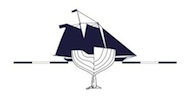WallyCento and MaxiScow - a new concept
The author thanks Donan Raven for the translation of his text.
Donan's blog: http://nuttyrave.blogspot.fr/
Publishing naval
architect François Chevalier's original design for an out-and-out racer
immediately reveals a great blend of today's most generalised trends for
breaking speed limits as well as displays the author's great ability to look
into the breadth of working concepts in yachting history and formalise a
proposal that could establish herself as a capable prize winner, advocating the
scow bow as tomorrow's cornerstone in building racing yachts.
Donan Raven.
Mr. Chevalier
writes:
I had had early
etchings for these two 100ft projects, which I named MScow, laying on my
draftboard since last summer, together with a Volvo Open 70 and an IMOCA Open
60.
 |
| The two MScow projects |
When the Volvo Ocean Race announced that future editions would use a
one-design, I decided to finalise the two 100ft sailing yachts: a Wally Cento
and a Maxi Scow.
 |
| WallyCento, lines and half-deck |
 |
| WallyCento, sailplan |
 |
| WallyCento, interior layout |
The reason to design
yet another Wally lays in the designation of the WallyCento rule itself: owners
remain keen on the combination of comfort, performance, modern design and
bleeding edge technology in a yacht. Even if the Wally Cento open box rule
forbids canting keels and includes a minimum displacement figure, she remains
true to the Wally essence which has begot its prestigious fleet: simple
handling, automated sailing systems, utterly flush decks, light and minimalist
interior spaces.
 |
| MaxiScow, lines and half-deck |
 |
| MaxiScow, sailplan |
 |
| MaxiScow, interior layout |
The "Record"
designation of the MaxiScow version, which features a more lightweight
displacement and a canting keel, rid of all the modcons and automation usually
presented in Wallys, targets ocean records and line honours in crewed races
such as the Newport-Bermuda, the Fastnet or the Sydney-Hobart.
As featured in the
wetted surface diagrams comparing the MScow concept with conventional monohulls
when heeling, the key advantage of the MScow is her stiffness, sailing at an
angle which would be three times smaller than a conventional yacht. On the one
hand, the righting moment is a lot more efficient, whether or not she is fitted
with a canting keel, and on the other hand, the keel remains in the centerline
under sail: The result is the MSow's better ability in pointing to windward, by
one or two degrees depending on configuration.
To improve the sailing platform's
performance, the bowsprit can be orientated and the clew of headsails can be
adjusted in the lateral plane.
As far back as the
1970s, I made a concept for a crossoceanic windsurf designated for a
double-handed Transatlantic race. As for many projects of this kind, the model
is still hanging on my office wall. The idea remerged ten years ago when I
wrote an article investigating the orgins of planing hulls. The craze which
governed the American skimming dishes at the turn of the twentieth century,
with waterline length as the only limitation, had given me the idea to develop
an IMOCA Open 60 for the Vendée Globe single-handed circumnavigation race.
I decided to develop a
progressive chine-bilged scow, and instead of a pram bow, I proceeded to cut
away the stem very significantly to avoid wave slamming as much as possible. By
tapering the bow both in height and in width, shocks with head waves are dampened
significantly and the scow skims the surface immediately and displacing as
little water as possible.
François Chevalier, August 4th, 2012
| specifications | WallyCento | MaxiScow |
| naval architecture | Francois Chevalier YD | Francois Chevalier YD |
| build | carbonfiber, built to WallyCento open rule | carbonfiber |
| Length Over All | 100ft (30.48m) | 100ft (30.48m) |
| Load Waterline Length | 87ft 7 in (26.70m) | 87ft 7 in (26.70m) |
| beam | 23ft 7in (7.20m) | 23ft 7in (7.20m) |
| draught | maximum 20ft 4in (6.20m), minimum 14ft 9in (4.50m), dropkeel | 18ft 4in (4.50m) canting keel |
| displacement | 45 tonnes | 38 tonnes |
| air draught | 147ft 8in (45m) | 150ft 11in (46m) |
| mainsail + jib area | 6,370sqft (592m²) | 6,760sqft (628m²) |
| mainsail + gennaker area | 11,000sqft (1000m²) | 11,900sqft (1110m²) |




Merci pour post!
RépondreSupprimer